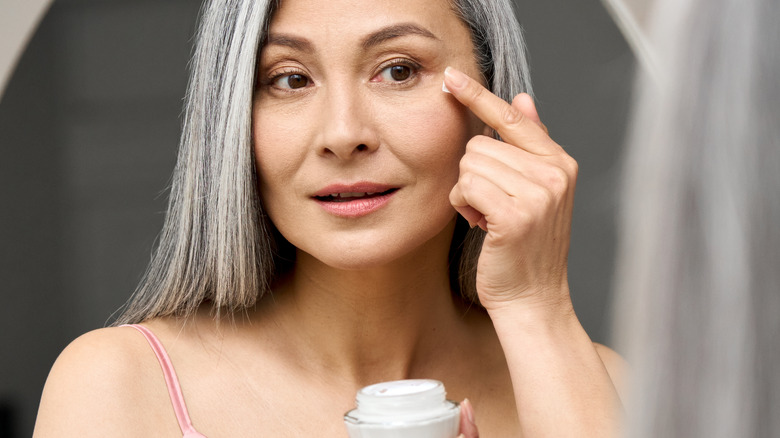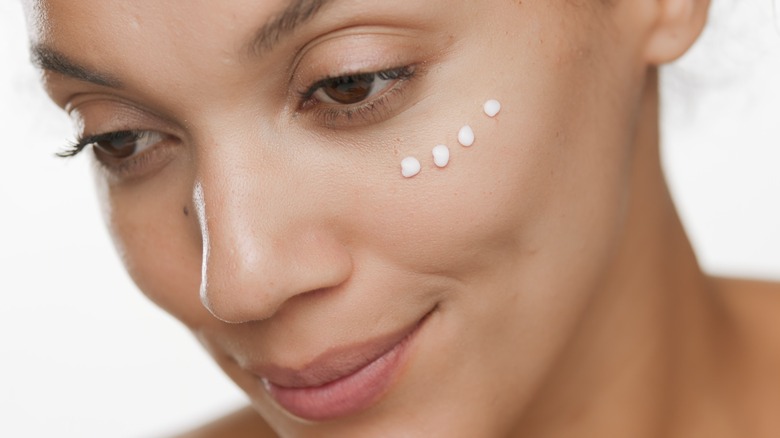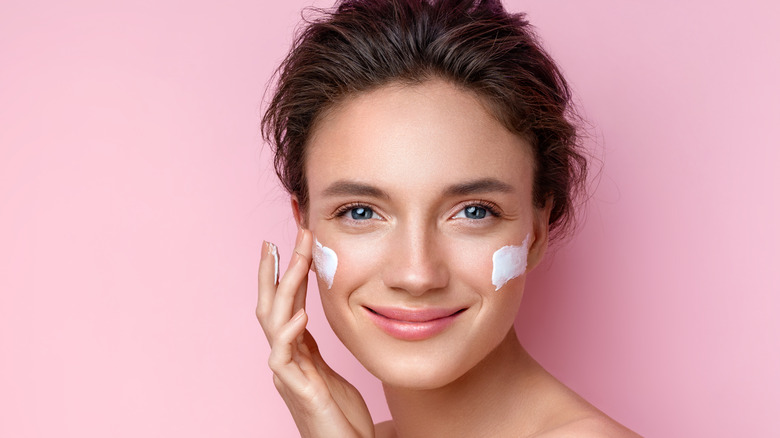How To Apply Eye Cream The Right Way For Optimal Results
It's fair to expect a surprise or two if you ever visit an esthetician. Brace yourself once you've run through your skincare routine and it includes, say, an eye cream. "Show me," your trusty skin care specialist might say as they hand you a jar. Don't get the wrong idea. They don't doubt you, nor do they expect you to stare at the jar as if you've never seen eye cream before. It's not that kind of test. They literally want you to show them how you apply it.
It may help to remember that you made the appointment in the first place to learn something, change something you're doing, or do something new so that your skin looks better. Don't be surprised if you cover all three categories in one visit, primarily if you use eye cream — and even if you've been using it for years. The simple fact is that many people are prone to make some type of mistake with eye cream. And all those years of repetitive practice have done nothing but make those habits more entrenched and more brutal to break.
It probably doesn't help that eye creams target one of the most sensitive parts of the body: the undereye area, where the skin is thin and fragile. It's also where "the unholy trinity" of aging is likely to appear: fine lines and wrinkles, dark circles, and puffiness (via Clearstem Skincare).
Make the right moves
Some of the more common ingredients in eye creams include caffeine, retinol, vitamin C, and hyaluronic acid (via Woman & Home). These ingredients may sound familiar to you, but the American Academy of Dermatology recommends deciding what your "No. 1 aging-skin concern" is and selecting an eye cream that contains the ingredient to address it. It pays to be selective, for the AAD clearly says, "No product can treat all signs of skin aging."
Apply the cream correctly to give it every chance to make a difference. Your first move may be the most influential: pick up a pea-sized amount of cream with your ring finger. As your least mobile finger, it will also exert the lightest touch (via L'Oréal). Dab that first pea-sized dot of cream under your eye, near the inner corner. If you're happy with the size, you can use it as a "model" for the dots to follow. This can prevent you from applying too much cream and irritating your skin.
Keep applying small dots of the cream under your eyes until you reach the outer corner (via Healthline). If you blink and accidentally pick up some cream on your lashes, you've applied too much, so reduce the size of the dots. Once you've formed a semi-circle of dots under both eyes, tap — don't rub — all the cream into your skin. Leave it there for about five minutes so it can absorb before you apply moisturizer and/or makeup.
Follow other pointers
You don't have to tell a soul if end up getting anything less than a passing grade from your watchful esthetician. Besides, another "do" or "don't" of applying eye cream may register against your guilty conscience. You still have some things to learn. For example, you may not know that it's smart to apply moisturizer before you apply eye cream. Moisturizer provides what WENmedics calls "an extra boost of hydration" to the sensitive undereye area.
So, by all means, wash your face. Blot your face dry. Apply facial moisturizer. And then apply eye cream. And you can follow this routine both in the morning and before you go to bed — not just the latter, as many people seem to think. You can never take "too" much care of your eye area. You can overdo your enthusiasm for the endeavor, though. Rubbing the cream, even quickly or haphazardly, can exacerbate puffiness and dark circles. So, practice another new move as you tap the cream into your skin: gentle, upward, and outward strokes. And remember that ring finger. It still plays a starring role.
Some of these techniques may require practice; you may have been applying eye cream for so long that you barely think about what you're doing. Like brushing your teeth, it's practically rote. But if you've learned something, will change something that you've been doing, or will do something new, you better believe that your skin should know and respond in kind.


